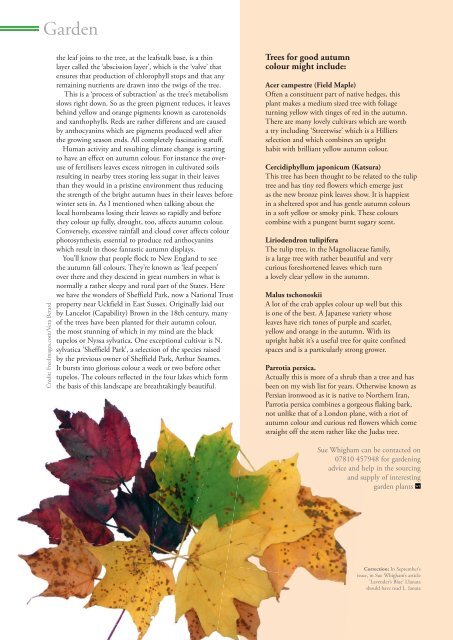Wealden Times | WT188 | October 2017 | Kitchen & Bathroom supplement inside
Wealden Times - The lifestyle magazine for the Weald
Wealden Times - The lifestyle magazine for the Weald
You also want an ePaper? Increase the reach of your titles
YUMPU automatically turns print PDFs into web optimized ePapers that Google loves.
Garden<br />
Credit: FreeImages.com/Vera Berard<br />
the leaf joins to the tree, at the leafstalk base, is a thin<br />
layer called the ‘abscission layer’, which is the ‘valve’ that<br />
ensures that production of chlorophyll stops and that any<br />
remaining nutrients are drawn into the twigs of the tree.<br />
This is a ‘process of subtraction’ as the tree’s metabolism<br />
slows right down. So as the green pigment reduces, it leaves<br />
behind yellow and orange pigments known as carotenoids<br />
and xanthophylls. Reds are rather different and are caused<br />
by anthocyanins which are pigments produced well after<br />
the growing season ends. All completely fascinating stuff.<br />
Human activity and resulting climate change is starting<br />
to have an effect on autumn colour. For instance the overuse<br />
of fertilisers leaves excess nitrogen in cultivated soils<br />
resulting in nearby trees storing less sugar in their leaves<br />
than they would in a pristine environment thus reducing<br />
the strength of the bright autumn hues in their leaves before<br />
winter sets in. As I mentioned when talking about the<br />
local hornbeams losing their leaves so rapidly and before<br />
they colour up fully, drought, too, affects autumn colour.<br />
Conversely, excessive rainfall and cloud cover affects colour<br />
photosynthesis, essential to produce red anthocyanins<br />
which result in those fantastic autumn displays.<br />
You’ll know that people flock to New England to see<br />
the autumn fall colours. They’re known as ‘leaf peepers’<br />
over there and they descend in great numbers in what is<br />
normally a rather sleepy and rural part of the States. Here<br />
we have the wonders of Sheffield Park, now a National Trust<br />
property near Uckfield in East Sussex. Originally laid out<br />
by Lancelot (Capability) Brown in the 18th century, many<br />
of the trees have been planted for their autumn colour,<br />
the most stunning of which in my mind are the black<br />
tupelos or Nyssa sylvatica. One exceptional cultivar is N.<br />
sylvatica ‘Sheffield Park’, a selection of the species raised<br />
by the previous owner of Sheffield Park, Arthur Soames.<br />
It bursts into glorious colour a week or two before other<br />
tupelos. The colours reflected in the four lakes which form<br />
the basis of this landscape are breathtakingly beautiful.<br />
Trees for good autumn<br />
colour might include:<br />
Acer campestre (Field Maple)<br />
Often a constituent part of native hedges, this<br />
plant makes a medium sized tree with foliage<br />
turning yellow with tinges of red in the autumn.<br />
There are many lovely cultivars which are worth<br />
a try including ‘Streetwise’ which is a Hilliers<br />
selection and which combines an upright<br />
habit with brilliant yellow autumn colour.<br />
Cercidiphyllum japonicum (Katsura)<br />
This tree has been thought to be related to the tulip<br />
tree and has tiny red flowers which emerge just<br />
as the new bronze pink leaves show. It is happiest<br />
in a sheltered spot and has gentle autumn colours<br />
in a soft yellow or smoky pink. These colours<br />
combine with a pungent burnt sugary scent.<br />
Liriodendron tulipifera<br />
The tulip tree, in the Magnoliaceae family,<br />
is a large tree with rather beautiful and very<br />
curious foreshortened leaves which turn<br />
a lovely clear yellow in the autumn.<br />
Malus tschonoskii<br />
A lot of the crab apples colour up well but this<br />
is one of the best. A Japanese variety whose<br />
leaves have rich tones of purple and scarlet,<br />
yellow and orange in the autumn. With its<br />
upright habit it’s a useful tree for quite confined<br />
spaces and is a particularly strong grower.<br />
Parrotia persica.<br />
Actually this is more of a shrub than a tree and has<br />
been on my wish list for years. Otherwise known as<br />
Persian ironwood as it is native to Northern Iran,<br />
Parrotia persica combines a gorgeous flaking bark,<br />
not unlike that of a London plane, with a riot of<br />
autumn colour and curious red flowers which come<br />
straight off the stem rather like the Judas tree.<br />
Sue Whigham can be contacted on<br />
07810 457948 for gardening<br />
advice and help in the sourcing<br />
and supply of interesting<br />
garden plants<br />
Correction: In September’s<br />
issue, in Sue Whigham’s article<br />
‘Lavender’s Blue’ LIanata<br />
should have read L. Ianata


















